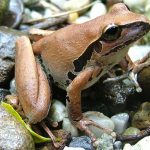EASTERN STONY CREEK FROG
The Eastern Stony-creek Frog is a medium-sized frog, typically ranging from 4 to 7 centimetres in length. Its skin is smooth and usually green or brown, often with a mottled pattern that helps it blend seamlessly into its natural surroundings. The frog’s back may feature irregular dark spots, and it often has a distinctive pale stripe running from its snout to its rear. Its underbelly is generally a creamy white.
This frog is commonly found along the eastern coast of Australia, from northern New South Wales to far north Queensland. It thrives in a variety of environments, including rocky streams, creeks, and other freshwater bodies, particularly those surrounded by lush vegetation. It is an excellent climber, often found clinging to rocks and vegetation near water. These habitats provide both the moisture and the cover essential for their survival.
The Eastern Stony-creek Frog is primarily insectivorous, feeding on a diet of insects and other small invertebrates. Its hunting strategy involves waiting patiently for prey to come close before quickly snapping it up with its sticky tongue.
Breeding occurs mostly during the warmer months, from late spring to early autumn. Males call from the edges of streams and creeks to attract females with a distinctive, repetitive croak. Once a mate is found, the female lays her eggs in water, where they develop into tadpoles. These tadpoles eventually metamorphose into juvenile frogs, a process that can take several weeks.
While the exact lifespan of the Eastern Stony-creek Frog in the wild is not well-documented, many frogs of similar size and habitat can live for several years, often up to 5 to 10 years, depending on environmental conditions and predation pressures.
Currently, the Eastern Stony-creek Frog is listed as Least Concern by the International Union for Conservation of Nature (IUCN). However, like many amphibians, it faces threats from habitat destruction, pollution, and climate change. Conservation efforts are essential to ensure its continued survival.
The call of the Eastern Stony-creek Frog is a series of short, repeated croaks that can be heard during the breeding season. These calls are crucial for attracting mates and establishing territories.
In many Indigenous Australian cultures, frogs hold significant cultural and ecological importance. They are often seen as indicators of environmental health and are featured in various stories and traditions. While specific cultural connections to the Eastern Stony-creek Frog may vary, frogs in general are respected as part of the natural world.
In summary, the Eastern Stony-creek Frog is a resilient and adaptable species, integral to the ecosystems it inhabits. Protecting its habitat ensures the survival of this and many other species that share its environment.

